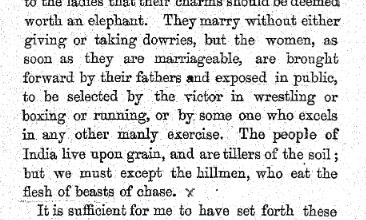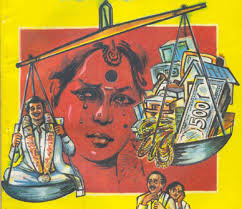Contrary to what Islamic Invaders, British and Leftist historians say to project Brahmin's as oppressing class, Historic evidences on the ground speaks differently. Let us see the case of "Dowry".
The west says, women in India were "oppressed". This was simply a western template. Women were treated as "an object" in most parts of world till 20th century. They were traded like commodity (even in Europe). As, women were available for a " small fee", parents, who want their daughter to be settled in marriage respectfully, had to offer a price in lump-sum called, "Dowry". This "Dowry " was to motivate groom to be loyal to his wife and to create an obligation in marriage contract. If the groom breaks loyalty/marriage, he had to return the "Dowry". This was acting as a barrier for adultery and was protecting the marriage.
Now come back to India and check the historic facts. There was no case for "Dowry" in India, as women were not available like commodities. In-fact the demand was other way. To get a good wife, a man has to prove his mantle. Check Mahabharatha. It starts with the story of a "Kuru" prince getting attracted to a lady belonging to fishermen community (satyavathi). Although the lady was his subject, king was not in a position to seize her and force a marriage. The lady in question, dictated terms to the ruling monarch that, she will take his hand, only if he publicly assure royal succession to their marriage. She did it to secure respect in royal court, as she was not from any ruling family. No one, including here parents could pursue her to change her mind in the interest of the state. Women definitely enjoyed the highest possible freedom. King could not accept the demand and was helpless, as he was bound to protect the interest of state. He already had the ablest prince-in-waiting Bheeshma. Finally Bheeshma, the most powerful warrior of his time ,(till his death) had to sacrifice his married life, to fulfill the demand. This clearly demonstrates king was not superior than his subjects from his role, position, power, religion,caste etc. No one could break rule of law (was called Dharma in those days) at that time by quoting silly exceptions or by exploiting loop holes. Forget commoners, King himself was not allowed to use his force to subjugate a woman in marriage. Freedom to choose her companion without any force was a "right" awarded to woman by Dharma/collective will of society. It was not possible to break this rule with any pretext. Story in Mahabharata was a "testimony" to Indian civility.
While "wild west" was beastly, India transformed in to most prosperous civilization (since the time of Vedas). In Vedas, we see many ladies composing and contributing to creation of hymns. Many Hymns were dedicated to women sages. We see worship of "mother goddess" from vedic literature itself. When a woman has to be judged, people were advised to look at her as a mother and then judge. The tagging helped to bring "respect" in all walks of life and bought fair degree of favor for women in all considerations. When everything fails, "Kings mother" was the last ray of hope for restraining kings power. Women were respected and were exempted from hard labor (which was not the case in west. women were assigned labor in taking social burden, but were not paid in equity, an exact opposite of India). Many exemptions were awarded in punishments also. Lactating women were generally pardoned (or let off with a small fine) in the interest of the child (no such examples in west. In fact you see burning of women with false accusations of witch craft). All these practices demonstrates the epitome of civility and provides proof on the ground against accusations like "exploitation".
Women were married off in swayamwara, without any dowry. Note, the bride was choosing the man of her choice (not her parents). Parents were only arranging the competition. Bride was free to set conditions. This is recorded in Megashanese (a Greek ambassador) book Indica (Recording date 300 BC) as follows.
There was a possibility of worst humiliation to a reigning and powerful king, if he participate. But still society has forced this practice on king, to protect the freedom of bride. Forceful marriages used to result in "war" like situations. It was expensive to conduct swayamwaras. So, at commoner level, groom was evaluated by parents. This evaluation turned in to payment of a "fee" to in-laws. The payment was for 2 purpose, one to cover the cost of upbringing the girl child and second was to prove, groom is really committed to the marriage and will take care of the woman for life. It was also a show off for the groom and his family. However, slowly this practice of giving "payment" for marriage turned nasty. Some greedy parents started to demand "ransoms", forcing the groom to take loans and suffer through out his life.
When this was debated in royal court of Vijaynagar (in 15th century), Brahmin's came together and abolished any financial transaction in marriages. See the record attached.
( Reference:- The above is extracted from
SOCIAL AND POLITICAL LIFE IN THE VIJAYANAGARA EMPIRE (A. D. 1346--A. D. 1646) VOLUME II BY Dr. B. A. SALETORE, M.A., Ph. D.. (Lond. et Giessen) Alexander von Humboldt Stiftnng Scholar, Berlin WITH A FOREWORD BY Dr. S. KRISHNASWAMI AIYANGAR, M.A.. Ph.D. Professor of Indian History and Archaeology (Retd.), Madras Thesis approved for the Decree of Doctor of Philosophy in the University of London, 1931 MADRAS B. G. PAUL ® CO. Publishers 12. Francis Joseph Street 1954 Published with the aid Publication Fund of the of a Grant from the University of London,
You can access the copy here
https://archive.org/stream/in.ernet.dli.2015.183842/2015.183842.Social-And-Political-Life-In-The-Vijayanagara-Empirevolii_djvu.txt
)
The Brahmin's act, clearly shows, they were leading the social reforms and were the trend setters for "civility". Note, the proclamation at kings court was "a self restraint" and was not a "royal decree". Brahmins were doing a social reform by following it first (walk the talk). This happened in 15th century (Before, Britishers could even dream of entering India). Islamists started "slave trade" before Britishers and tried to introduce it in India. But India did not oblige. As there were no buyers in India, invaders were taking captured people in war to trade them as slaves in middle east. Transporting slaves on foot was a very tedious job. Transporting of slaves to Arabia, proves that, slave trade and subjugation was not possible during Muslim rule also. Note, Muslim documentation boasts about sending captured people to Arabia as slaves (or distributing with Muslim army), but never say a word of selling them in "India" itself.
Andre Wink summarizes the slavery in 8th and 9th century India as follows,
(During the invasion of Muhammad al-Qasim), invariably numerous women and children were enslaved. The sources insist that now, in dutiful conformity to religious law, 'the one-fifth of the slaves and spoils' were set apart for the caliph's treasury and dispatched to Iraq and Syria. The remainder was scattered among the army of Islam. At Rūr, a random 60,000 captives reduced to slavery. At Brahamanabad 30,000 slaves were allegedly taken. At Multan 6,000. Slave raids continued to be made throughout the late Umayyad period in Sindh, but also much further into Hind, as far as Ujjain and Malwa. The Abbasid governors raided Punjab, where many prisoners and slaves were taken.
— Al Hind, André Wink
Compare this to what Megasthanese documents about India in his book Indica
Finally due to British policy of altering "trade" equations, farmers and artisans lost their earning opportunity and became poor. This poorness "reversed" the trend of "Dowry" in marriages. As marriages got struck due to economic status of groom, brides parents started a practice of giving household items or a consideration (bootstrap investment) to motivate young people to start families. This was done to protect the institution of marriage. Not able to prove the "financial strength was a great humiliation to grooms. So, unable to bear the humiliation, many used to change their mind and run away at the last moment, saying they will go to "Banaras".
The brides father used to console and bring back the groom. This practice has become a tradition and one can still see this act in Brahman marriages in south.
Note, going to Banaras (from south India for pilgrimage) was the last resort in old age. This used to happen after relinquishing all assets and liabilities. Young people used to do it, when they wanted to take "sanyasa". If not for a humiliation, Why would a young man run away to "Banaras" from marriage hall?
Muslim rules and Britishers were guilty of introducing current practice of "Dowry" in India. The reversal in paying groom (rather than paying for bride) probably happened in late 18th-19th century. But, The historians put the blame on Indian tradition and project entire country in "bad light". Media ran a serious of mind washing campaigns depicting woman in "victim hood" to ensure Indians believe, their own tradition was exploitative.
Todays, Abolition of Dowry, through Dowry act did not come from western preachings, but they have a firm base (Vijaynagar court ruling), in Indian history itself.








No comments:
Post a Comment